December 22, 1927
Los Angeles
Let’s put up our feet and see what’s gone on in the world this day. Not much. The odd curiosity or two. 
According to our concerned friends at the paper, it seems the Mexicans are making a menace of themselves, using flowers of the “hemp” plant as some sort of habit-forming drug (they’re such a resourceful people!). Apparently the Imperial Linen Products Company has blanketed the Imperial Valley with the stuff. Well, I’m sure the State will sort this one out to everybody’s satisfaction.
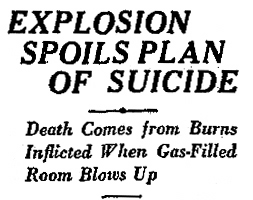 Oh dear, here’s another fellow who just couldn’t resist a final cigarette. Seems J. B. Smith left the wife at his Glendale home and checked into the LaViolette Hotel on North Maclay in San Fernando. He brought with him a stack of goodbye letters indicating his fears about going mad, and a loaf of bread—not for snacking, but for soaking in water and wadding into the wafty windows and drafty doors (my hat off again to the resourcefulness of our Southlanders). Of course, no-one banks on the dang’d jets taking so long. Thankfully J. B. also brought along a pack of smokes to pass the time…the hole blown in the wall was six feet in diameter. J. B.’s smoldering remains lived long enough to say goodbye to his wife at the hospital, but not much longer than that.
Oh dear, here’s another fellow who just couldn’t resist a final cigarette. Seems J. B. Smith left the wife at his Glendale home and checked into the LaViolette Hotel on North Maclay in San Fernando. He brought with him a stack of goodbye letters indicating his fears about going mad, and a loaf of bread—not for snacking, but for soaking in water and wadding into the wafty windows and drafty doors (my hat off again to the resourcefulness of our Southlanders). Of course, no-one banks on the dang’d jets taking so long. Thankfully J. B. also brought along a pack of smokes to pass the time…the hole blown in the wall was six feet in diameter. J. B.’s smoldering remains lived long enough to say goodbye to his wife at the hospital, but not much longer than that.
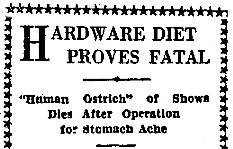 And oh my, it seems one of my favorite attractions of the stage, Sidney Barnes the Human Ostrich, has expired in New Orleans. After complaining of stomach pains, the Homo Struthio underwent an operation to remove a cigar box full of bolts, carpet tacks, razor blades, washers and nails from therein—Barnes did not emerge alive. Guess growing up to be a carnival side can be rough, kids!
And oh my, it seems one of my favorite attractions of the stage, Sidney Barnes the Human Ostrich, has expired in New Orleans. After complaining of stomach pains, the Homo Struthio underwent an operation to remove a cigar box full of bolts, carpet tacks, razor blades, washers and nails from therein—Barnes did not emerge alive. Guess growing up to be a carnival side can be rough, kids!

And what do have we here…a Coroner’s inquest will be held at 1:30 today to determine whether Ralph McCoy, in City Jail on suspicion of robbery, actually hung himself in his cell or was killed by fellow prisoners—it seems McCoy bears (well, bore) a resemblance to one William Edward Hickman.
Oh yeah. Hickman. Some mention in the paper about him, too.
![]()

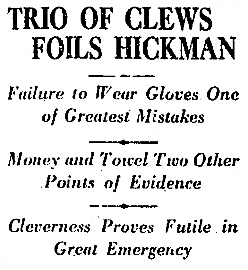


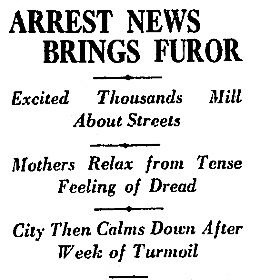
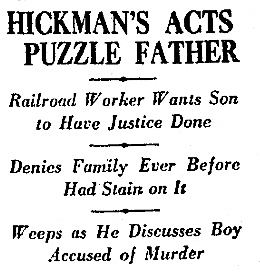
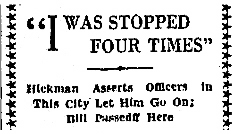

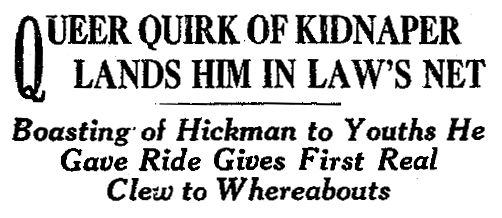


![]()

![]()
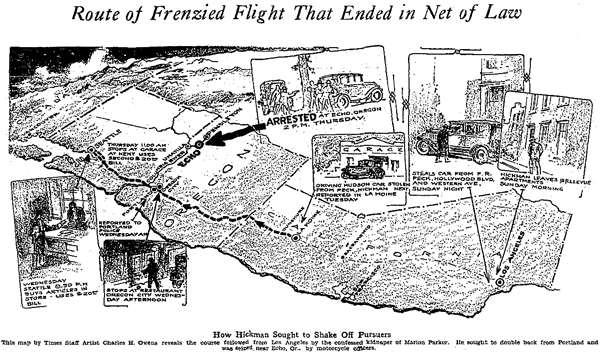


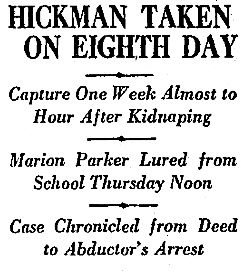
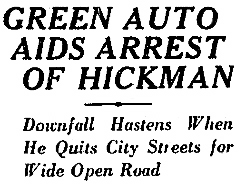




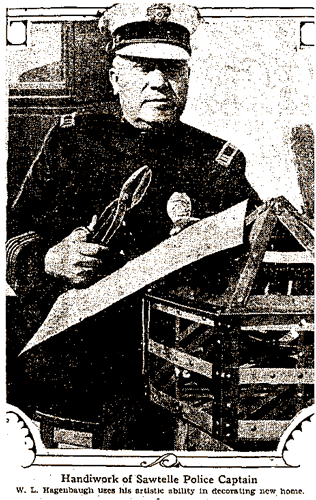 December 16, 1927
December 16, 1927
 December 15, 1927
December 15, 1927 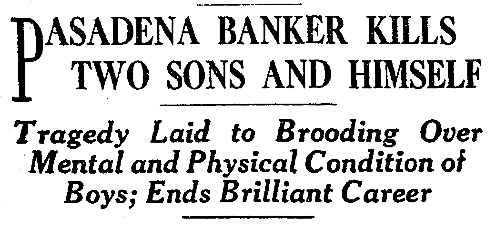

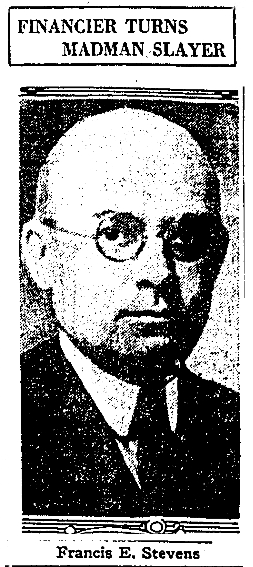 December 8, 1927
December 8, 1927 They walked and talked along the shady paths and across sun-dappled lawns until they came to the tennis court in the rear. It was 12:15 when father pulled out and brought a pistol to his son’s temple and fired. He was then seen sliding the barrel into his mouth and pulling the trigger, his body crumpling directly next to his son’s.
They walked and talked along the shady paths and across sun-dappled lawns until they came to the tennis court in the rear. It was 12:15 when father pulled out and brought a pistol to his son’s temple and fired. He was then seen sliding the barrel into his mouth and pulling the trigger, his body crumpling directly next to his son’s.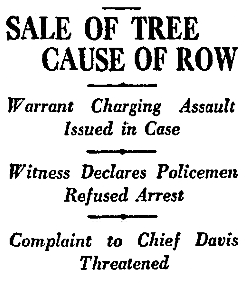 December 8, 1927
December 8, 1927 On a related note—here in the future—I like my palm tree. A lot. And who can blame me? So when I looked out my window and saw someone chainsawing up the palm in front of my home, I was close to grabbing something a lot stronger than a can of seasoning. (Never mind that it wasn’t really my palm—but on an embankment in front of my house—I loved my palm, dammit.) When the overscale condo development went up across the street from me, they stretched high-tension wires across to it. And then the DWP decided that the decades-old
On a related note—here in the future—I like my palm tree. A lot. And who can blame me? So when I looked out my window and saw someone chainsawing up the palm in front of my home, I was close to grabbing something a lot stronger than a can of seasoning. (Never mind that it wasn’t really my palm—but on an embankment in front of my house—I loved my palm, dammit.) When the overscale condo development went up across the street from me, they stretched high-tension wires across to it. And then the DWP decided that the decades-old 
 New York
New York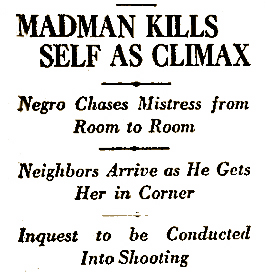 Mrs. Margaret Pumphrey, 27, of the
Mrs. Margaret Pumphrey, 27, of the 

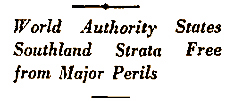 Whew indeed! It seems that the menace of an earthquake disaster is greatly exaggerated, and we’ve erroneous data to thank for that (usually from the prophesies of Stanford’s Dr. Bailey Willis, who, Hill feels, is full of hooey)—and which is responsible for the marked rise in earthquake insurance rates. Dr. Hill was corroborated in his assertions and supported with geological data by one
Whew indeed! It seems that the menace of an earthquake disaster is greatly exaggerated, and we’ve erroneous data to thank for that (usually from the prophesies of Stanford’s Dr. Bailey Willis, who, Hill feels, is full of hooey)—and which is responsible for the marked rise in earthquake insurance rates. Dr. Hill was corroborated in his assertions and supported with geological data by one 

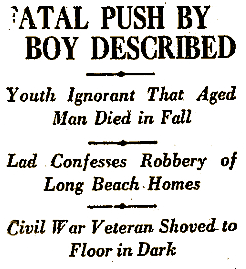
 November 24, 1927
November 24, 1927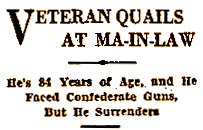 In further news of the Boys in Blue, another Damn’d Yankee, this one in Spokane, has problems of another variety. “I’m living on borrowed time,” said Enoch A. Sears, 84, “far past my allotted three score and ten, and I only want peace and quiet.” He has filed for divorce from his wife of one year, and has departed his home, leaving it to his wife, 59, and her mother, 79. Enoch simply stated he was “too old to become accustomed to living with a mother-in-law.”
In further news of the Boys in Blue, another Damn’d Yankee, this one in Spokane, has problems of another variety. “I’m living on borrowed time,” said Enoch A. Sears, 84, “far past my allotted three score and ten, and I only want peace and quiet.” He has filed for divorce from his wife of one year, and has departed his home, leaving it to his wife, 59, and her mother, 79. Enoch simply stated he was “too old to become accustomed to living with a mother-in-law.”